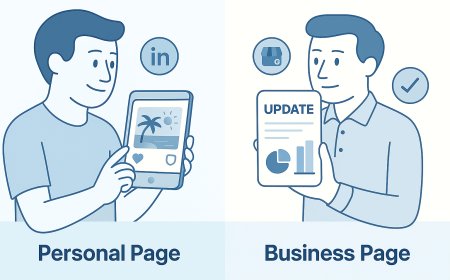The Future of Web Development: Insights from Leading Indian Company
Discover key trends and future directions in web development from a top Indian web development company, helping businesses stay ahead in the digital world.

The internet never stands stilland neither does web development. As user habits shift and technology advances, websites must keep evolving to stay relevant, fast, and easy to use. Whether it's shopping online, booking a table, or just browsing a blog, people expect smooth, secure, and visually appealing experiences. Thats why businesses are turning to a trusted Web development company in India to build websites that not only meet modern standards but also adapt quickly to future demands.
To understand where web development is heading, we took a closer look at insights shared by a leading web development company in India.
In this blog, well break down what the future of web development looks likewhats changing, whats staying, and what you need to know to keep your digital presence ahead of the curve.
1. Speed and Performance Will Be Non-Negotiable
Speed remains the top priority for websites. Users expect pages to load within 2-3 seconds. If a site takes longer, visitors leave, leading to lost customers and lower search rankings.
Web developers are adapting by:
-
Using lightweight frameworks like Next.js and Astro
-
Optimizing images and media
-
Reducing unnecessary code and scripts
-
Leveraging Content Delivery Networks (CDNs) for global speed
Even a one-second improvement in load time can boost conversions by up to 20%.
2. Mobile-First and Then Desktop
Mobile devices now dominate internet usage. This makes mobile-first design essential.
Key mobile-first features include:
-
Touch-friendly buttons and menus
-
Fast-loading images optimized for small screens
-
Responsive layouts that adjust to any device
-
Click-to-call and map integration for local businesses
With the majority of traffic coming from mobile, websites that dont perform well on phones miss out on a large audience.
3. AI Is Changing Everything
Artificial Intelligence is becoming a core part of web development. AI-powered features like chatbots, product recommendations, smart search, and content suggestions enhance user experience and personalization.
In the future, AI will tailor entire websites to individual visitors, showing personalized content and designs that fit each users preferences.
4. Voice Search and Accessibility Are Growing Fast
Voice assistants like Alexa and Siri have made voice search popular. Websites need to optimize content for voice queries and add voice search capabilities.
Accessibility is also gaining importance. Websites must be usable for people with disabilities by:
-
Adding descriptive alt-text for images
-
Ensuring keyboard navigation
-
Using high-contrast colors
-
Supporting screen readers
Accessibility will soon be a legal requirement, not just a best practice.
5. Progressive Web Apps (PWAs) Will Replace Many Native Apps
PWAs offer app-like experiences via websites. They work offline, send push notifications, and can be installed on devices without app stores.
PWAs are:
-
Cheaper and faster to build than native apps
-
Easier to maintain with a single codebase
-
Great for engaging and retaining users
Many businesses, especially in e-commerce and local services, are adopting PWAs.
6. Headless CMS Is Gaining Popularity
Headless CMS platforms separate backend content management from frontend presentation, allowing content to be published across websites, apps, smart devices, and voice assistants seamlessly.
Popular tools like Strapi, Contentful, and Sanity.io are making headless CMS solutions accessible to businesses of all sizes.
7. Real-Time Features Are Becoming Standard
Real-time data and instant updates improve user trust and experience. Examples include:
-
Real-time table availability for restaurants
-
Stock updates for e-commerce stores
-
Progress tracking on learning platforms
Technologies like WebSockets, Firebase, GraphQL, and live APIs support these features.
8. Strong Focus on Security and Privacy
With rising cyber threats and privacy regulations, websites must be secure by design.
Key security practices include:
-
HTTPS encryption (SSL certificates)
-
GDPR compliance
-
Protection against SQL injection, cross-site scripting, and phishing
-
Secure payment gateways for online transactions
Regular backups and security audits are essential for long-term safety.
9. Visual Storytelling and Micro-Animations Will Be Everywhere
Static websites are giving way to dynamic, engaging experiences through:
-
Scroll-triggered animations
-
Hover effects
-
Animated product reveals
-
Video backgrounds
-
Interactive storytelling sections
These wow moments help create emotional connections with visitors without sacrificing performance.
10. Collaboration Between Designers, Developers, and Marketers
The best websites result from close teamwork between designers, developers, and marketers from the start.
This collaboration ensures websites are:
-
Aligned with brand identity
-
Optimized for speed and scalability
-
Strategically designed for SEO and conversions
Final Thoughts
The future of web development is exciting, fast, and user-focused. Whether you're a startup, a local business, or a growing brand, you need a website that:
-
Loads fast
-
Works on all devices
-
Connects with users in real-time
-
Offers smart, personalized experiences
-
Is secure and accessible
-
Supports your marketing goals
This is where professional Web development services in India can make a real difference. Partnering with a skilled web development company can help bring this vision to life.
They not only understand the latest technologies but also know how to apply them in practical ways that drive real results for your business.







































